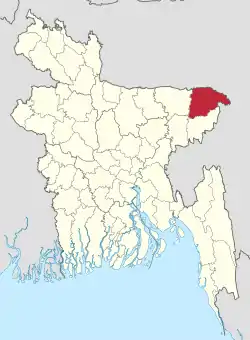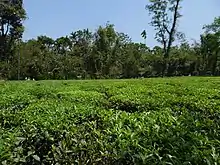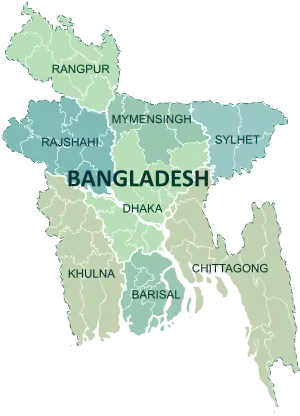Sylhet
সিলেট জেলা | |
|---|---|
| Sylhet District | |
  .JPG.webp)   | |
 Location of Sylhet District in Bangladesh | |
Expandable map of Sylhet District | |
| Coordinates: 24°53′N 91°52′E / 24.883°N 91.867°E | |
| Country | |
| Division | Sylhet Division |
| Established | 1772 |
| Government | |
| • Deputy Commissioner | Md. Mozibor Rahman[1] |
| Area | |
| • Total | 3,452.07 km2 (1,332.85 sq mi) |
| Population (2022 census)[3] | |
| • Total | 3,857,037 |
| • Density | 1,100/km2 (2,900/sq mi) |
| Demonym | Sylheti |
| Time zone | UTC+06:00 (BST) |
| Postal code | 3100 |
| HDI (2018) | 0.596[4] medium · 11th of 21 |
| Website | sylhet |
Sylhet District (Bengali: সিলেট জেলা), located in north-east Bangladesh, is one of the four districts in the Sylhet Division, which contains Sylhet, the regional capital.
History
Sylhet district was created in 1772 after this area was acquired by the British in 1767 and Mr. William Thackeray was appointed as the first collector. Current Sylhet district consists of 12 (Twelve) upazilas. There is an attempt to make this web portal useful to the needs of information seekers. It contains detailed information on various important government departments, resources, publications, education, agriculture, medicine, tourism and housing. The process of continuously enriching the web portal will continue. Sylhet district was established on 3 January 1782, and until 1878 it was part of Bengal Province under Dhaka Division. However, in that year, Sylhet was moved to the newly created Assam Province, and it remained as part of Assam up to 1947 (except during the administrative reorganisation of Bengal Province between 1905 and 1912). Sylhet district was divided into five subdivisions and the current Sylhet District was known as the North Sylhet subdivision. In 1947, Sylhet became a part of East Pakistan as a result of a referendum (except 31⁄2 thanas of Karimganj subdivision) as part of Chittagong Division.[5] It was subdivided into four districts in 1983–84 with the current Sylhet District being known as North Sylhet. It became a part of Sylhet Division after its formation in 1995. Sylhet has played a vital role in the Bangladeshi economy. Several of Bangladesh's finance ministers have been Members of Parliament from the city of Sylhet.[5]
Demographics
| Year | Pop. | ±% p.a. |
|---|---|---|
| 1981 | 1,777,784 | — |
| 1991 | 2,153,301 | +1.93% |
| 2001 | 2,555,566 | +1.73% |
| 2011 | 3,434,188 | +3.00% |
| 2022 | 3,857,037 | +1.06% |
| Sources:[3][6] | ||
According to the 2022 Census of Bangladesh, Sylhet District had a population of 3,857,037, 21.9% of whom lived in urban areas. The household size was 5.2. The population density was 1,117 people per km2. The literacy rate (age 7 and over) was 76.3%, compared to the national average of 74.7%.[3]
| Religion | Population (1941)[7]: 36–37 | Percentage (1941) | Population (2011)[6] | Percentage (2011) |
|---|---|---|---|---|
| Islam |
561,124 | 73.34% | 3,180,766 | 92.62% |
| Hinduism |
189,226 | 24.73% | 248,154 | 7.23% |
| Tribal religion |
14,360 | 1.88% | 2,174 | 0.06% |
| Others [lower-alpha 2] | 361 | 0.05% | 3,094 | 0.09% |
| Total Population | 765,071 | 100% | 3,434,188 | 100% |
Muslims make up 92.52% of the population while Hindus are 7.32% of the population. Ethnic population is 12,781, mainly Khasi.
Administration
Sylhet District is divided into thirteen upazilas.[5]
The upazilas are:
Geography and climate

Sylhet has a typical Bangladeshi tropical monsoon climate (Köppen Am) bordering on a humid subtropical climate (Cwa) at higher elevations. The rainy season starts from April to October and it is so hot and humid with very heavy showers and thunderstorms almost every day, whilst the short dry season starts from November to February and it is very warm and fairly clear. Nearly 80% of the annual average rainfall of 4,200 millimetres (170 in) occurs between May and September.[8]
The city is located within the region where there are hills and basins which constitute one of the most distinctive regions in Bangladesh. The physiography of Sylhet consists mainly of hill soils, encompassing a few large depressions known locally as "beels" which can be mainly classified as oxbow lakes, caused by tectonic subsidence primarily during the earthquake of 1762.
Geologically, the region is complex having diverse sacrificial geomorphology; high topography of Plio-Miocene age. Available limestone deposits in different parts of the region suggest that the whole area was under the ocean in the Oligo-Miocene. In the last 150 years three major earthquakes hit the city, at a magnitude of at least 7.5 on the Richter Scale, the last one took place in 1918, although many people are unaware that Sylhet lies on an earthquake prone zone.[9]
| Month | Jan | Feb | Mar | Apr | May | Jun | Jul | Aug | Sep | Oct | Nov | Dec | Year |
|---|---|---|---|---|---|---|---|---|---|---|---|---|---|
| Mean daily maximum °C (°F) | 25.2 (77.4) |
27.1 (80.8) |
30.4 (86.7) |
30.8 (87.4) |
30.8 (87.4) |
30.9 (87.6) |
30.9 (87.6) |
31.6 (88.9) |
31.2 (88.2) |
30.9 (87.6) |
29.2 (84.6) |
26.3 (79.3) |
29.6 (85.3) |
| Mean daily minimum °C (°F) | 12.9 (55.2) |
14.2 (57.6) |
18.1 (64.6) |
20.8 (69.4) |
22.6 (72.7) |
24.4 (75.9) |
24.9 (76.8) |
25.0 (77.0) |
24.3 (75.7) |
22.5 (72.5) |
18.4 (65.1) |
14.0 (57.2) |
20.2 (68.3) |
| Average rainfall mm (inches) | 8 (0.3) |
31 (1.2) |
146 (5.7) |
372 (14.6) |
569 (22.4) |
796 (31.3) |
834 (32.8) |
621 (24.4) |
548 (21.6) |
232 (9.1) |
30 (1.2) |
13 (0.5) |
4,200 (165.1) |
| Source: WMO[10] | |||||||||||||
Notable people
- M.A.G. Osmani Commander-in-Chief of the Mukti Bahini during the Liberation War.
- Md. Saifur Rahman former Finance and Planning Minister
- Shah Jalal, Sufi saint and mystic.
- Shah Paran, Sufi saint
- Shah Abdul Karim, Baul folk singer, composer.
- Swami Nikhilananda, Ramakrishna Math and Mission Order monk and founder-minister, Ramakrishna-Vivekananda Center, New York City 1933–1973
- Swami Gambhirananda, Ramakrish Math and Mission Order monk and president of the Order 1985–1988
- Nurul Islam Nahid, former Education Minister of Bangladesh
- Govinda Chandra Dev (1 February 1907 – 26 March 1971), known as G. C. Dev, was a professor of philosophy at the University of Dhaka. He was assassinated at the onset of Bangladesh Liberation War of 1971 by the Pakistan Army.
- Dr Abdul Malik, National Professor, Brigadier (rtd.), cardiologist, founder and president of National Heart Foundation of Bangladesh.
- Rushanara Ali, first Bangladeshi to be elected as an MP for the British parliament
- Ajmal Masroor, television presenter, politician and imam, parliamentary candidate for a UK Parliament constituency
- Lutfur Rahman, the first elected mayor of the London Borough of Tower Hamlets council
- Mukhlesur Rahman Chowdhury, former minister and adviser to the president of Bangladesh
- Humayun Rashid Choudhury, diplomat, UN General Assembly President, Awami League leader and former speaker of National parliament
- Dilwar Khan, poet
- Salman Shah, film actor, model
- Shuvro Dev, playback singer
- Syed Ahmed, businessman, British TV personality
- Badar Uddin Ahmed Kamran, Mayor of Sylhet City Corporation (2003–13)
- Enam Ali, restaurateur and founder of the British Curry Awards
See also
Notes
- ↑ North Sylhet subdivision and Beanibazar thana of Sylhet district
- ↑ Including Jainism, Christianity, Buddhism, Zoroastrianism, Judaism, Ad-Dharmis, or not stated
References
- ↑ pmis.mopa.gov.bd/pmis/Forms/dclist.php
- ↑ "registered through Argeweb". geohive.com. Archived from the original on 26 February 2014.
- 1 2 3 4 Population and Housing Census 2022: Preliminary Report. Bangladesh Bureau of Statistics. August 2022. pp. viii, 28, 30, 39, 44, 46. ISBN 978-984-35-2977-0.
- ↑ "Sub-national HDI – Area Database – Global Data Lab". hdi.globaldatalab.org. Retrieved 18 March 2020.
- 1 2 3 Ashfaq Hossain (2012). "Sylhet District". In Sirajul Islam and Ahmed A. Jamal (ed.). Banglapedia: National Encyclopedia of Bangladesh (Second ed.). Asiatic Society of Bangladesh.
- 1 2 "Bangladesh Population and Housing Census 2011 Zila Report – Sylhet" (PDF). Bangladesh Bureau of Statistics.
- ↑ "Census of India, 1941 Volume IX Assam Province" (PDF). 1941.
- ↑ Monthly Averages for Sylhet, BGD Archived 1 July 2019 at the Wayback Machine MSN Weather. Retrieved 25 May 2009.
- ↑ Siddiquee, Iqbal (10 February 2006). "Sylhet growing as a modern urban centre". Our Cities: 15th Anniversary Special. The Daily Star. Retrieved 25 May 2009.
- ↑ "Climatological Information". WMO. Retrieved 20 January 2015.
External links
![]() Media related to Sylhet District at Wikimedia Commons
Media related to Sylhet District at Wikimedia Commons
